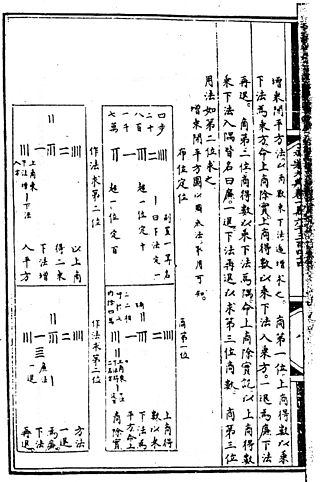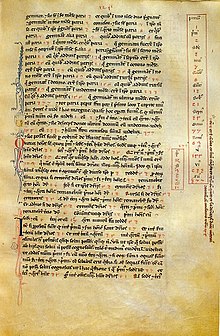The ten Arabic numerals 0, 1, 2, 3, 4, 5, 6, 7, 8, and 9 are the most commonly used symbols for writing numbers. The term often also implies a positional notation using the numerals, as well as the use of a decimal base, in particular when contrasted with other systems such as Roman numerals. However, the symbols are also used to write numbers in other bases such as octal, as well as for writing non-numerical information such as trademarks or license plate identifiers.

Arithmetic is an elementary branch of mathematics that studies numerical operations like addition, subtraction, multiplication, and division. In a wider sense, it also includes exponentiation, extraction of roots, and taking logarithms.

Fibonacci, also known as Leonardo Bonacci, Leonardo of Pisa, or Leonardo Bigollo Pisano, was an Italian mathematician from the Republic of Pisa, considered to be "the most talented Western mathematician of the Middle Ages".

A number is a mathematical object used to count, measure, and label. The most basic examples are the natural numbers 1, 2, 3, 4, and so forth. Numbers can be represented in language with number words. More universally, individual numbers can be represented by symbols, called numerals; for example, "5" is a numeral that represents the number five. As only a relatively small number of symbols can be memorized, basic numerals are commonly organized in a numeral system, which is an organized way to represent any number. The most common numeral system is the Hindu–Arabic numeral system, which allows for the representation of any non-negative integer using a combination of ten fundamental numeric symbols, called digits. In addition to their use in counting and measuring, numerals are often used for labels, for ordering, and for codes. In common usage, a numeral is not clearly distinguished from the number that it represents.
0 (zero) is a number representing an empty quantity. Adding 0 to any number leaves that number unchanged. In mathematical terminology, 0 is the additive identity of the integers, rational numbers, real numbers, and complex numbers, as well as other algebraic structures. Multiplying any number by 0 has the result 0, and consequently, division by zero has no meaning in arithmetic.
A numerical digit or numeral is a single symbol used alone or in combinations, to represent numbers in a positional numeral system. The name "digit" comes from the fact that the ten digits of the hands correspond to the ten symbols of the common base 10 numeral system, i.e. the decimal digits.

An Egyptian fraction is a finite sum of distinct unit fractions, such as

Algorism is the technique of performing basic arithmetic by writing numbers in place value form and applying a set of memorized rules and facts to the digits. One who practices algorism is known as an algorist. This positional notation system has largely superseded earlier calculation systems that used a different set of symbols for each numerical magnitude, such as Roman numerals, and in some cases required a device such as an abacus.

A unit fraction is a positive fraction with one as its numerator, 1/n. It is the multiplicative inverse (reciprocal) of the denominator of the fraction, which must be a positive natural number. Examples are 1/1, 1/2, 1/3, 1/4, 1/5, etc. When an object is divided into equal parts, each part is a unit fraction of the whole.

In number theory, a practical number or panarithmic number is a positive integer such that all smaller positive integers can be represented as sums of distinct divisors of . For example, 12 is a practical number because all the numbers from 1 to 11 can be expressed as sums of its divisors 1, 2, 3, 4, and 6: as well as these divisors themselves, we have 5 = 3 + 2, 7 = 6 + 1, 8 = 6 + 2, 9 = 6 + 3, 10 = 6 + 3 + 1, and 11 = 6 + 3 + 2.

A fraction represents a part of a whole or, more generally, any number of equal parts. When spoken in everyday English, a fraction describes how many parts of a certain size there are, for example, one-half, eight-fifths, three-quarters. A common, vulgar, or simple fraction consists of an integer numerator, displayed above a line, and a non-zero integer denominator, displayed below that line. If these integers are positive, then the numerator represents a number of equal parts, and the denominator indicates how many of those parts make up a unit or a whole. For example, in the fraction 3/4, the numerator 3 indicates that the fraction represents 3 equal parts, and the denominator 4 indicates that 4 parts make up a whole. The picture to the right illustrates 3/4 of a cake.
Lattice multiplication, also known as the Italian method, Chinese method, Chinese lattice, gelosia multiplication, sieve multiplication, shabakh, diagonally or Venetian squares, is a method of multiplication that uses a lattice to multiply two multi-digit numbers. It is mathematically identical to the more commonly used long multiplication algorithm, but it breaks the process into smaller steps, which some practitioners find easier to use.
The Erdős–Straus conjecture is an unproven statement in number theory. The conjecture is that, for every integer that is 2 or more, there exist positive integers , , and for which

The Hindu–Arabic numeral system is a positional base ten numeral system for representing integers; its extension to non-integers is the decimal numeral system, which is presently the most common numeral system.
In mathematics, the greedy algorithm for Egyptian fractions is a greedy algorithm, first described by Fibonacci, for transforming rational numbers into Egyptian fractions. An Egyptian fraction is a representation of an irreducible fraction as a sum of distinct unit fractions, such as 5/6 = 1/2 + 1/3. As the name indicates, these representations have been used as long ago as ancient Egypt, but the first published systematic method for constructing such expansions was described in 1202 in the Liber Abaci of Leonardo of Pisa (Fibonacci). It is called a greedy algorithm because at each step the algorithm chooses greedily the largest possible unit fraction that can be used in any representation of the remaining fraction.

Rod calculus or rod calculation was the mechanical method of algorithmic computation with counting rods in China from the Warring States to Ming dynasty before the counting rods were increasingly replaced by the more convenient and faster abacus. Rod calculus played a key role in the development of Chinese mathematics to its height in Song Dynasty and Yuan Dynasty, culminating in the invention of polynomial equations of up to four unknowns in the work of Zhu Shijie.
Abacus school is a term applied to any Italian school or tutorial after the 13th century, whose commerce-directed curriculum placed special emphasis on mathematics, such as algebra, among other subjects. These schools sprang up after the publication of Fibonacci's Book of the Abacus and his introduction of the Hindu–Arabic numeral system. In Fibonacci's viewpoint, this system, originating in India around 400 BCE, and later adopted by the Arabs, was simpler and more practical than using the existing Roman numeric tradition. Italian merchants and traders quickly adopted the structure as a means of producing accountants, clerks, and so on, and subsequently abacus schools for students were established. These were done in many ways: communes could appeal to patrons to support the institution and find masters; religious institutions could finance and oversee the curriculum; independent masters could teach pupils. Unless they were selected for teaching occupations that were salaried, most masters taught students who could pay as this was their main source of income.
A timeline of numerals and arithmetic.
This is a timeline of pure and applied mathematics history. It is divided here into three stages, corresponding to stages in the development of mathematical notation: a "rhetorical" stage in which calculations are described purely by words, a "syncopated" stage in which quantities and common algebraic operations are beginning to be represented by symbolic abbreviations, and finally a "symbolic" stage, in which comprehensive notational systems for formulas are the norm.
Al-Hassar or Abu Bakr Muhammad ibn Abdallah ibn Ayyash al-Hassar was a 12th-century Moroccan mathematician. He is the author of two books Kitab al-bayan wat-tadhkar, a manual of calculation and Kitab al-kamil fi sinaat al-adad, on the breakdown of numbers. The first book is lost and only a part of the second book remains.





















